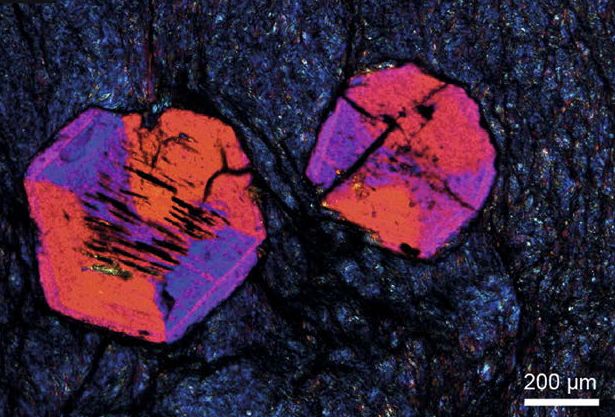Magnesiowüstite/hematite inclusions associated with residual carbonate reveal the origin of super-deep diamonds
Super-deep diamonds and their mineral inclusions preserve very precious information about Earth’s deep mantle. We examined multiphase inclusions entrapped within a super-deep diamond from the Rio Vinte e um de Abril, São Luiz area (Juina, Brazil), using a combination of non-destructive methods. Micro-Computed X-ray Tomography (μ-CXRT) was used to investigate the size, shape and distribution, while X-Ray absorption, micro X-ray Fluorescence (μ-XRF), μ-Raman Spectroscopy and micro-Fourier Transform Infrared Spectroscopy were used to determine the chemical and mineralogical composition of the inclusions. Four large inclusions within the N-rich diamond core (Fig. 1) were found to consist of dominant ferropericlase–magnesiowüstite, with locally exsolved magnesioferrite, and carbonates.
Fig. 1 The diamond sample sample and the inclusions studied in with the FTIR map of the N-defect measured at the SINBAD beamline.
A large inclusion (Fig. 2) (ca 100 μm) was remarkable because it showed a very unusual flask shape, resembling a fluid/melt inclusion. Based on μCXRT tomography and μ-Raman mapping, the flask-shaped inclusion is polyphase and consists of magnetite and hematite partly replacing a magnesiowüstite core and small-volume of gas/vacuum. μ-Raman spectra on the same inclusion revealed local features that are ascribed to post-spinel polymorphs, such as maohokite or xieite, which are stable at P ≥ 18 GPa, and to huntite, a carbonate with formula CaMg3(CO3)4. This represents the first finding of maohokite and huntite in diamond. We interpret the composition of the inclusions as evidence of formation of ferropericlase–magnesiowüstite and diamond in a carbonate-rich environment at depths corresponding at least to the Transition Zone, followed by oxidation of ferropericlase–magnesiowüstite by reaction with relatively large-volume entrapped melt during diamond ascent.

Fig. 2 Enlarged vision of a large inclusion together with the high-resolution FTIR image of the entrapped carbonate.
[1] Agrosì, G., Tempesta, G., Mele, D., Caggiani, M.C., Mangone, A., Della Ventura, G., Cestelli-Guidi, M., Allegretta, I., Hutchison, M.T., Nimis, P., Nestola, F. , Multiphase inclusions associated with residual carbonate in a transition zone diamond from Juina (Brazil). Lithos, 350-351 (2019) 105279. DOI: 10.1016/j.lithos.2019.105279
Contacts:
Prof. Giancarlo Della Ventura
Dipartimento di Scienza, Università Roma Tre
Giancarlo.DellaVentura@uniromatre.it

